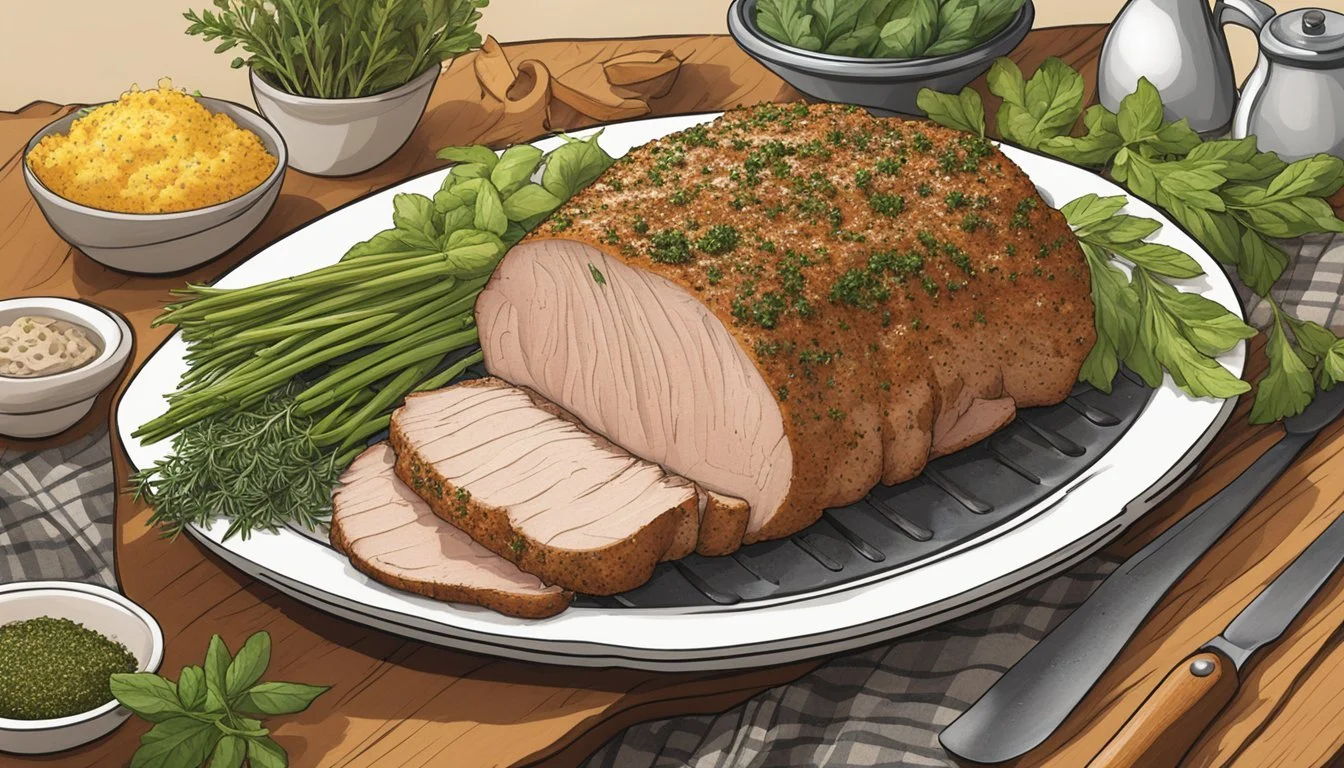How to Cook a Juicy 6-Pound Pork Loin
Perfect Roasting Tips
Cooking a 6-pound pork loin can be a delicious and satisfying endeavor for any home chef. This cut of meat offers a perfect balance of flavor and tenderness when prepared correctly. To cook a 6-pound pork loin, preheat the oven to 425°F, then roast for 15 minutes before reducing the temperature to 375°F and continuing to cook for approximately 2 to 2.5 hours.
The key to a perfectly cooked pork loin lies in achieving the right internal temperature. Use a meat thermometer to ensure the pork reaches 145°F at its thickest point. This temperature guarantees safe consumption while maintaining the meat's juiciness.
Seasoning plays a crucial role in enhancing the pork loin's natural flavors. A simple rub of herbs, garlic, salt, and pepper can transform this humble cut into a mouthwatering centerpiece for any meal. Remember to let the roast rest for 5-10 minutes after cooking to allow the juices to redistribute throughout the meat.
Selecting the Perfect Pork Loin
Choosing the right cut of pork is crucial for a successful roast. The quality and characteristics of the meat will significantly impact your final dish.
Understanding Different Cuts of Meat
Pork loin and pork tenderloin are distinct cuts that require different cooking methods. Pork loin is a larger, wider cut from the back of the pig. It's typically sold as a 2-5 pound roast and has a fat cap on one side. Pork tenderloin is a smaller, longer cut from beneath the loin. It's usually 1-2 pounds and very lean.
Pork loin is ideal for roasting due to its size and fat content. The fat helps keep the meat moist during longer cooking times. Tenderloin cooks much faster and is better suited for quick, high-heat methods.
Choosing Boneless Pork Loin
For a 6-pound roast, select a boneless pork loin. Boneless cuts are easier to carve and often cook more evenly. Look for a loin with a layer of fat on top, about 1/4 inch thick. This fat will render during cooking, adding flavor and moisture.
Choose a pork loin with a pinkish-red color and some marbling. Avoid meat that's pale or has dark spots. The texture should be firm but not hard. Fresh pork loin should have little to no odor. If possible, ask the butcher for a center-cut loin for the most uniform shape and even cooking.
Preparation Essentials
Properly preparing a 6-pound pork loin is crucial for achieving a flavorful and juicy result. Two key steps can significantly enhance the final dish.
Trimming the Fat Cap
The fat cap on a pork loin serves a purpose but requires careful trimming. Leave about 1/4 inch of fat to baste the meat during cooking. Use a sharp knife to score the remaining fat in a diamond pattern. This allows seasonings to penetrate and creates an appealing crispy texture.
Trim away any silver skin, as it becomes tough when cooked. Pat the loin dry with paper towels before seasoning. This step ensures better browning and flavor development.
Brining for Flavor and Juiciness
Brining infuses the pork loin with moisture and flavor. Create a basic brine using 1 cup of salt and 1 cup of sugar per gallon of water. Add aromatics like garlic cloves, peppercorns, and bay leaves for extra depth.
Submerge the pork loin in the brine and refrigerate for 4-6 hours. Avoid brining for too long, as it can make the meat overly salty. After brining, rinse the loin thoroughly and pat it dry.
For a quicker option, try a dry brine. Rub salt, pepper, and herbs directly onto the meat and refrigerate for 2-3 hours before cooking.
Herbs and Seasonings
Herbs and spices elevate pork loin from ordinary to extraordinary. The right blend enhances flavor while complementing the meat's natural taste.
Creating a Spice Rub
A well-crafted spice rub is essential for a flavorful pork loin. Combine kosher salt, black pepper, garlic powder, and onion powder as a base. Add paprika for color and a subtle smoky taste.
For a 6-pound pork loin, use:
2 tablespoons kosher salt
1 tablespoon black pepper
1 tablespoon garlic powder
1 tablespoon onion powder
2 teaspoons paprika
Mix these ingredients in a bowl. Rub the blend all over the pork loin, ensuring even coverage. Press the spices into the meat gently.
For added depth, incorporate dried herbs like thyme or oregano. A teaspoon of mustard powder can provide a tangy kick.
Using Fresh Rosemary
Fresh rosemary imparts a robust, aromatic flavor to pork loin. Its piney scent complements the meat beautifully.
Strip 2-3 sprigs of fresh rosemary leaves from the stems. Finely chop the leaves and mix with:
2 tablespoons olive oil
2 cloves minced garlic
1 teaspoon kosher salt
1/2 teaspoon black pepper
Rub this mixture over the pork loin before roasting. For a more intense flavor, make small incisions in the meat and insert rosemary sprigs.
Alternatively, lay whole rosemary sprigs around the pork loin in the roasting pan. The heat will release aromatic oils, infusing the meat with flavor.
Roasting Techniques
Mastering pork loin roasting techniques ensures a juicy, flavorful result. The key factors are oven temperature, setup, and deciding whether to sear the meat before roasting.
Oven Temperature and Setup
Preheat the oven to 425°F (218°C) for initial high-heat cooking. Place a roasting pan in the oven's center rack. Line it with aluminum foil for easy cleanup. Use a rack inside the pan to elevate the pork loin, allowing hot air to circulate evenly.
After 15 minutes at high heat, reduce the temperature to 375°F (190°C). This two-stage approach creates a flavorful crust while maintaining interior moisture. Cook the pork loin for approximately 20-25 minutes per pound.
For a 6-pound pork loin, the total cooking time will be about 2 to 2.5 hours. Always use a meat thermometer to check doneness. The internal temperature should reach 145°F (63°C) for medium-rare.
To Sear or Not to Sear
Searing the pork loin before roasting can enhance flavor and appearance. Heat 2 tablespoons of oil in a large skillet over medium-high heat. Sear the loin for 4-6 minutes per side until golden-brown.
This step creates a flavorful crust through the Maillard reaction. It also helps seal in juices during roasting. However, searing is optional and may increase total cooking time.
If skipping the sear, apply a dry rub or herb paste to the loin before roasting. This adds flavor without the extra step. Either method can produce a delicious roasted pork loin when combined with proper oven techniques.
Cooking Time and Temperature
Proper cooking time and temperature are crucial for a perfectly cooked 6-pound pork loin. A balance of high heat to create a flavorful crust and lower heat for even cooking is key. Monitoring the internal temperature ensures food safety and optimal doneness.
Calculating Cooking Time
For a 6-pound pork loin, start by preheating the oven to 425°F (218°C). Roast the pork for 15 minutes to develop a crust. Then, reduce the temperature to 375°F (190°C) and continue cooking for about 20-25 minutes per pound. This means a total cooking time of approximately 2 to 2.5 hours.
The exact time can vary based on oven accuracy and the pork loin's shape. It's best to use the cooking time as a guideline rather than a strict rule. Factors like the pork's initial temperature and oven hot spots can affect cooking time.
Monitoring Internal Temperature
Using a meat thermometer is essential for determining doneness. Insert it into the thickest part of the pork loin, avoiding fat or bone. The safe internal temperature for pork is 145°F (63°C).
Check the temperature about 30 minutes before the estimated cooking time ends. This allows for adjustments if needed. Once the pork reaches 145°F, remove it from the oven. Let it rest for 3-5 minutes before slicing.
During resting, the internal temperature may rise slightly. This is normal and helps redistribute juices throughout the meat. A properly cooked pork loin will have a slight pink hue in the center and be juicy when sliced.
Resting and Carving
Proper resting and carving techniques are crucial for achieving a juicy, flavorful pork loin. These steps help retain moisture and ensure each slice is tender and delicious.
The Importance of Letting Meat Rest
After cooking, allow the pork loin to rest for 10-15 minutes. This resting period allows the internal juices to redistribute throughout the meat. Cover the roast loosely with foil to keep it warm.
During resting, the internal temperature of the pork loin will continue to rise slightly. This carryover cooking contributes to the final doneness of the meat.
Resting also makes carving easier, as the meat fibers relax and retain more moisture. This results in juicier slices when carved.
How to Carve for Maximum Juiciness
Place the rested pork loin on a cutting board. Use a sharp carving knife to slice against the grain of the meat. This technique ensures tender, easy-to-chew slices.
Aim for thin, even slices about 1/4 to 1/2 inch thick. Thinner slices are more tender and easier to eat.
Collect any pan juices and drizzle them over the carved meat for added flavor. Serve the pork loin slices immediately, accompanied by roasted carrots or other vegetables.
For presentation, arrange the slices on a platter in a fan pattern. Garnish with fresh herbs if desired.
Serving and Accompaniments
A perfectly cooked 6-pound pork loin deserves thoughtful accompaniments to create a well-rounded meal. Choosing the right side dishes and sauces can elevate the dining experience and complement the flavors of the roast.
Side Dish Selection
Mashed potatoes are a classic pairing for pork loin, offering a creamy texture that contrasts with the meat. For a lighter option, consider roasted potatoes seasoned with herbs like rosemary or thyme.
Brussels sprouts make an excellent vegetable side. Roast them with a drizzle of olive oil and balsamic vinegar for a caramelized flavor.
Sautéed apples and onions provide a sweet and savory element that pairs wonderfully with pork. Cook them in butter with a sprinkle of cinnamon for added warmth.
A crisp green salad with a lemon vinaigrette can add freshness to the plate. Include ingredients like arugula, thinly sliced fennel, or peppery watercress.
Complementing with a Sauce or Gravy
A well-made gravy enhances the pork's flavors. Use the pan drippings as a base, adding flour and stock to create a rich, savory sauce.
For a fruity twist, try an apple cider reduction. Simmer apple cider with a touch of Dijon mustard and fresh thyme until thickened.
A white wine sauce offers elegance. Deglaze the roasting pan with dry white wine, add cream, and reduce until slightly thickened. Finish with a pat of butter for richness.
Herb-infused butter is a simple yet effective option. Mix softened butter with chopped parsley, garlic, and lemon zest. Melt over the sliced pork just before serving.
Storing and Reheating
Proper storage and reheating techniques are crucial for maintaining the quality and safety of leftover pork loin. Correct methods preserve flavor, texture, and moisture while preventing foodborne illness.
Best Practices for Storage
Store leftover pork loin in the refrigerator within two hours of cooking. Place the meat in an airtight container or wrap it tightly in aluminum foil or plastic wrap. Properly stored pork loin can last 3-4 days in the fridge.
For longer storage, freeze the pork loin. Wrap it securely in freezer-safe packaging, removing as much air as possible. Frozen pork loin maintains quality for up to 6 months.
Always label containers with the date of storage. This practice helps track freshness and ensures timely consumption.
When ready to use, thaw frozen pork loin in the refrigerator overnight. Never thaw meat at room temperature, as this can lead to bacterial growth.
Reheating to Retain Moisture
Preheat the oven to 250°F (120°C) for gentle reheating. Place the pork loin in an oven-safe dish with a small amount of broth or water to create moisture.
Cover the dish tightly with aluminum foil. This traps steam and prevents the meat from drying out. Heat for 10-15 minutes per pound, or until the internal temperature reaches 145°F (63°C).
For quicker reheating, use a microwave. Cut the pork loin into slices and arrange them on a microwave-safe plate. Cover with a damp paper towel and heat in 30-second intervals, checking frequently to avoid overcooking.
Let the reheated pork loin rest for a few minutes before serving. This allows the juices to redistribute, ensuring a moist and flavorful result.
Additional Tips for Perfect Pork Loin
Mastering pork loin preparation involves selecting the right cooking method and recognizing when the meat is perfectly done. These techniques ensure a succulent, flavorful roast every time.
Choosing Cooking Methods
Oven roasting is a popular technique for cooking pork loin. Preheat the oven to 375°F for optimal results. For a 6-pound pork loin, plan on roasting for approximately 20 minutes per pound. Use a roasting pan with a rack to elevate the meat, allowing heat to circulate evenly.
Slow cooking is another excellent option. Place the pork loin in a slow cooker with broth or wine for 6-8 hours on low. This method yields exceptionally tender meat.
Grilling imparts a smoky flavor. Sear the loin over high heat, then move to indirect heat and cook until done. Brush with oil to prevent sticking.
Recognizing the Signs of Perfectly Cooked Pork
The internal temperature is crucial for determining doneness. Insert a meat thermometer into the thickest part of the loin. The USDA recommends cooking pork to 145°F, followed by a 3-minute rest.
At this temperature, the pork may have a slight pink hue. This is safe and indicates optimal juiciness. Overcooking leads to dry, tough meat.
Visual cues can help. The pork should be firm to the touch but still have some give. Clear juices should run when pierced with a fork.
Let the pork rest for 5-10 minutes after cooking. This allows juices to redistribute, ensuring a moist and flavorful roast.










